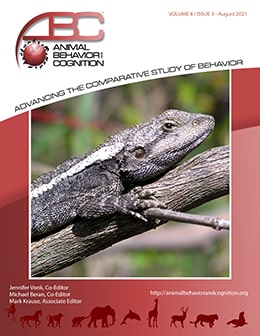Vol 8, Issue 3, August 2021
Testing the Relationship Between Looking Time and Choice Preference in Long-tailed Macaques
Citation
Wilson, V. A. D., Kade, C., & Fischer, J. (2021). Testing the relationship between looking time and choice preference in long-tailed macaques. Animal Behavior and Cognition, 8(3), 351-375. https://doi.org/10.26451/abc.08.03.03.2021
Abstract
Visual bias in social cognition studies is often interpreted to indicate preference, yet it is difficult to elucidate whether this translates to social preference. Moreover, visual bias is often framed in terms of surprise or recognition. It is thus important to examine whether an interpretation of preference is warranted in looking time studies. Here, using touchscreen training, we examined (1) looking time to non-social images in an image viewing task, and (2) preference of non-social images in a paired choice task, in captive long-tailed macaques, Macaca fascicularis. In a touchscreen test phase, we examined (3) looking time to social images in a viewing task, and (4) preference of social images in a paired choice task. Finally, we examined (5) looking time to social images in a non-test environment. For social content, the monkeys did not exhibit clear preferences for any category (conspecific/heterospecific, in-group/outgroup, kin/non-kin, young/old) in the explicit choice paradigm, nor did they differentiate between images in the viewing tasks, thus hampering our interpretation of the data. Post-hoc analysis of the training data however revealed a visual bias towards images of food and objects over landscapes in the viewing task. Similarly, across choice-task training sessions, food and object images were chosen more frequently than landscapes. This suggests that the monkeys’ gaze may indeed indicate preference, but this only became apparent for non-social stimuli. Why these monkeys had no biases in the social domain remains enigmatic. To better answer questions about attention to social stimuli, we encourage future research to examine behavioral measures alongside looking time.
Keywords
Macaca fascicularis, Visual bias, Social cognition, Attention, Gaze
